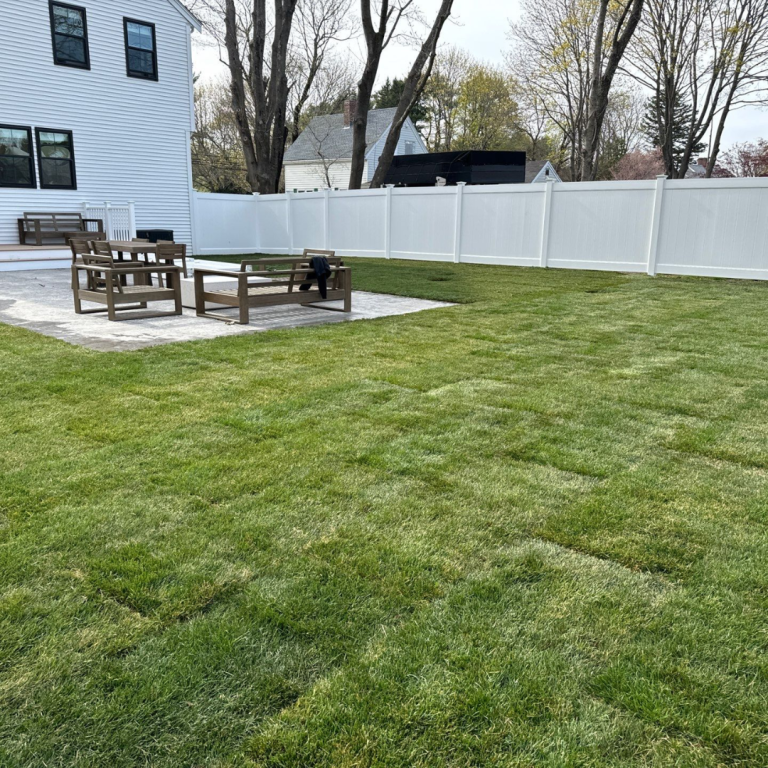Lawn Aeration, Repair, and Overseeding: The Keys to a Healthy, Lush Lawn
As the summer heat begins to wane and the crisp air of autumn arrives, lawn care and preparation for next year’s lush lawn may not be front of mind for many homeowners in Massachusetts. September is the ideal time to give your lawn the care it needs to thrive. It has three key tasks that should be on your to-do list: lawn aeration, repair, and overseeding. These essential lawn care practices not only enhance the appearance of your lawn but also contribute to its long-term health.
Why September is the Perfect Month for Lawn Care in Massachusetts
September ushers in the shift from the intense summer heat to the refreshing coolness of early fall. This transitional period, with its milder temperatures and more balanced weather, creates the perfect conditions for nurturing lawns in Massachusetts.
Warm soil temperature from residual summer heat: During the summer, the soil absorbs heat, and by September, it remains warm enough to promote root growth and seed germination. Warm soil temperatures (ideally between 55°F and 65°F) are crucial for the success of lawn aeration because they encourage active root development, making it easier for grass to recover from the aeration process and to establish new growth.
Improved root development during an active growth period: September falls within the cool-season grass growth cycle, which is common in Massachusetts. During this time, grasses such as Kentucky bluegrass, fescue, and ryegrass are in a period of active growth. Aeration during this growth phase allows the roots to take full advantage of the improved soil structure, leading to deeper, stronger roots.
Reduced stress on grass and moderate air temperatures: As the intense heat of summer fades, the cooler air temperatures in September reduce stress on the grass. This makes it easier for the lawn to recover after aeration and minimizes the risk of damage from the aeration process itself.
Increased moisture levels and consistent rainfall: September typically brings more consistent rainfall in Massachusetts. This natural moisture helps keep the soil soft and easier to penetrate during aeration. Additionally, the increased water availability aids in the recovery of the grass and supports new root growth.
Reduced competition from weeds: Many summer weeds begin to die off in September, reducing competition for resources like water, nutrients, and light. This allows the grass to take full advantage of the improved conditions created by aeration.
Preparing for winter: Aerating in September allows the grass to strengthen its root system before winter arrives. A robust root system helps the lawn survive the cold months and emerge healthier in the spring. The warm soil temperatures combined with cooler air create an optimal environment for root fortification.
The Critical Role of Aeration in Lawn Care
Lawn aeration is a process that involves perforating the soil with small holes to allow air, water, and nutrients to penetrate the grass roots. This task is crucial for maintaining a healthy lawn, especially in areas with compacted soil or heavy foot traffic.
Benefits of Lawn Aeration:
Improved Soil Structure: Aeration alleviates soil compaction, which can restrict root growth and reduce the lawn’s ability to absorb water and nutrients. By creating small holes in the soil, aeration allows roots to expand more freely, resulting in a stronger, healthier lawn.
Enhanced Nutrient Uptake: When the soil is compacted, essential nutrients like nitrogen, phosphorus, and potassium struggle to reach the grassroots. Aeration opens the soil, allowing these nutrients to reach the root zone more effectively.
Increased Water Infiltration: Compacted soil often leads to poor water absorption, causing runoff and potentially leaving your lawn dry and undernourished. Aeration improves water infiltration, ensuring your lawn receives the moisture it needs to thrive.
Reduced Thatch Buildup: Thatch is a layer of dead grass, roots, and debris that accumulates between the soil and the grass blades. Excessive thatch can suffocate the grass and prevent water and nutrients from reaching the roots. Aeration helps break down thatch, promoting a healthier lawn.
In Massachusetts, it’s generally recommended to aerate your lawn once every other year, preferably in the fall. However, if your lawn experiences heavy foot traffic or has clay soil, you may need to aerate it annually.
The Essentials of Lawn Repair and Overseeding
Lawn repair and overseeding involve restoring damaged or thin areas of your lawn by planting new grass seeds. This process is essential for maintaining a lush, green lawn, especially after the stress of summer heat, drought, or disease.
When is Lawn Repair and Overseeding Needed?
Thin or Bare Patches: If your lawn has developed thin or bare patches due to foot traffic, pet activity, or other stressors, it’s time to consider lawn repair and overseeding.
Weed Infestation: If weeds have overtaken sections of your lawn, overseeding can help crowd out the weeds and promote the growth of healthy grass.
Poor Color or Health: If your lawn appears dull, discolored, or unhealthy, overseeding can rejuvenate it by introducing new, vigorous grass varieties.
Benefits of Lawn Repair and Overseeding:
Thicker, Healthier Lawn: Overseeding introduces new grass seed into your lawn, filling in bare spots and thickening the turf. A thicker lawn is more resilient to weeds, disease, and environmental stressors.
Improved Grass Variety: Overseeding allows you to introduce newer, more disease-resistant grass varieties that can improve your lawn’s overall health and appearance.
Enhanced Disease Resistance: A diverse mix of grass species can make your lawn more resistant to diseases and pests, reducing the need for chemical treatments.
For most lawns, it’s recommended to overseed every two to three years. However, if your lawn has suffered significant damage or thinning, you may need to overseed annually. September is the ideal time to overseed because the warm soil and cooler air create the perfect conditions for seed germination and establishment.
September is the perfect month to give your lawn the care it deserves through aeration, repair, and overseeding. These essential lawn care tasks will enhance your lawn’s beauty and ensure its long-term health and vitality. With regular maintenance and attention, your lawn will remain lush, green, and the envy of the neighborhood for years to come.
Mass Lawn Pros is a South Shore Massachusetts-based landscape design, construction & maintenance business serving residential and commercial properties. Mass Lawn Pros brings decades of local expertise to their clients and is known for their exceptional customer service and reliable workmanship. From lush, green lawns, and stunning hardscapes to seasonal cleanups, tree pruning, and commercial plowing, Mass Lawn Pros ensures every project meets our high standards of excellence. Mass Lawn Pros services the communities of Norwell, Hanover, Hingham, Pembroke, Marshfield, Scituate, Cohasset, Weymouth, Braintree, Quincy, Milton, Dorchester, and Rockland. Contact us today for a free estimate and let us help you create and maintain your perfect outdoor space.


